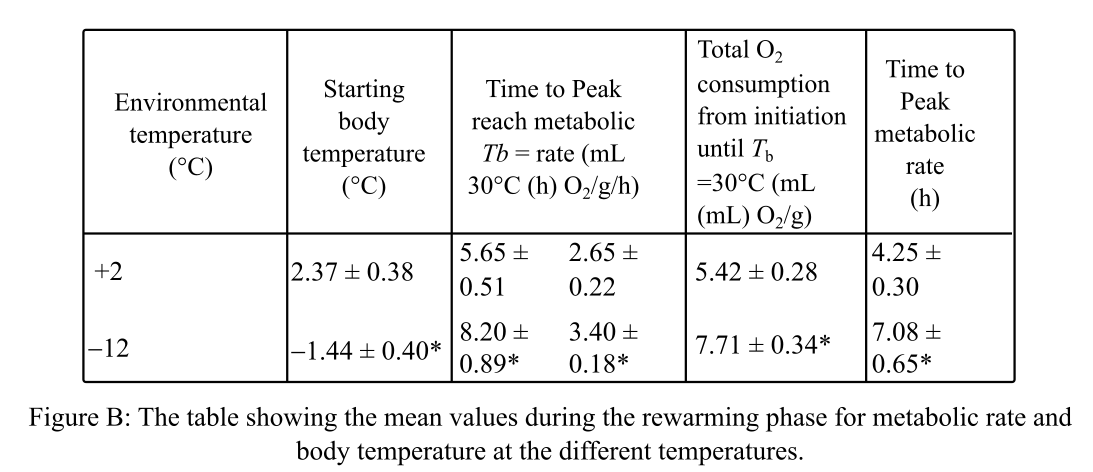
To analyze:
The effect of environmental temperature on time to reach a Tb at 30°C and the effect of initial body temperature on the rate of rewarming.
Given:
The arctic ground squirrels were kept in the hibernating chambers by the researchers. These squirrels can build the burrows that can reach –10°C. The hibernating chambers in the laboratory were held at either +2°C or –12°C. It was observed that all the squirrels taken into consideration entered bouts of torpor repeatedly. The body temperatures (Tb) and the
The table reports the mean values during the rewarming phase for metabolic rate and body temperature plus or minus (±) the standard error for the two groups of squirrels at the different ambient temperatures. An asterisk (*) indicates that the mean values were significantly different from each other.


Introduction:
Animals always keep the pace between its body temperature and environmental changes associated with it. They produce heat via metabolic activity and continuously evert the same into the surroundings. This adaptation helps them to stay warm even at the low temperature.
Explanation of Solution
The environmental temperature affects the time to reach a Tb of 30°C as given in the graph. When the temperature of the surroundings drops down far beneath the working range of the cell, then more time is required to reach Tb. It takes times to dissipate the heat into the environment in order to achieve an optimal temperature inside the body for the normal physiological functioning of the cell.
The rate of rewarming gets easily affected by the initial body temperature. If the initial body temperature is near to the temperature against which the body has to be regulated, the time required will be too less than to achieve the regulatory temperature having a lot of marginal difference between its initial body temperature.
It can be concluded that the endothermic animals react differently to the environmental temperature. The rate of rewarming gets affected by the initial body temperature.
Want to see more full solutions like this?
Chapter 39 Solutions
Life: The Science of Biology
- In your own words, explain how you determine the susceptibility for tooth decay for individuals using the Snyder test? ( your answer should refer to lactic acid production, pH indicator or color change and time component)arrow_forwardHow can tampon use increase the risk of toxic shock syndrome?arrow_forwardExplain the post exposure process ?arrow_forward
- List four benefits of fever.arrow_forwardWhen does a TBI occur?arrow_forwardAn 18-year-old patient reports a low-grade fever, itchy and red eyes, pain in the right ear, as well as a mild cough and runny nose. Vitals Temperature - 100.1 °F Heart Rate - 88 bpm Respiratory Rate - 18 bpm Oxygen Saturation - 94 BP - 124/78 What is the diagnosesarrow_forward
 Human Physiology: From Cells to Systems (MindTap ...BiologyISBN:9781285866932Author:Lauralee SherwoodPublisher:Cengage Learning
Human Physiology: From Cells to Systems (MindTap ...BiologyISBN:9781285866932Author:Lauralee SherwoodPublisher:Cengage Learning Principles Of Radiographic Imaging: An Art And A ...Health & NutritionISBN:9781337711067Author:Richard R. Carlton, Arlene M. Adler, Vesna BalacPublisher:Cengage Learning
Principles Of Radiographic Imaging: An Art And A ...Health & NutritionISBN:9781337711067Author:Richard R. Carlton, Arlene M. Adler, Vesna BalacPublisher:Cengage Learning





